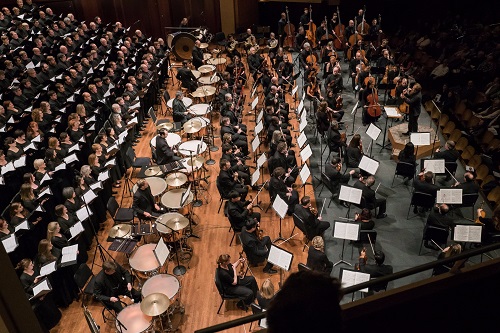 United States Berlioz: Kenneth Tarver (tenor), Seattle Symphony Chorale, Seattle Pro Musica, Vocalpoint! Seattle, Seattle Symphony / Ludovic Morlot (conductor), Benaroya Hall, Seattle, 11.11.2017. (ZC)
United States Berlioz: Kenneth Tarver (tenor), Seattle Symphony Chorale, Seattle Pro Musica, Vocalpoint! Seattle, Seattle Symphony / Ludovic Morlot (conductor), Benaroya Hall, Seattle, 11.11.2017. (ZC)

Berlioz – Grande messe des morts Op.5
Live performances of Hector Berlioz’s Grande messe des morts—usually referred to simply as his Requiem—are a rare occurrence, given its sheer size. Berlioz mandates hundreds musicians and singers for his ‘great mass for the dead’, including 16 timpani and four brass bands strategically placed throughout the concert hall. The composer’s instructions even allow for hundreds more musicians if needed or desired to fill a particular space. But just as daunting as the physical size of the ensemble is the score’s vast emotional and spiritual reach.
Berlioz’s modifications to the mass text, unconventional orchestration, numerous contemplative stretches, and frequent use of small orchestral forces—even with hundreds of musicians on stage—generate more questions than answers. The Requiem stands apart from the rest of his works because of its deeply spiritual nature. Berlioz had been eager to apply his strange ideas to the form, and was finally given the chance when Minister of the Interior, Comte Adrien de Gasparin, commissioned him to write a mass honoring the 1830 Revolution and the people who lost their lives. Is the Requiem an orchestral spectacle in search of meaning or is the meaning right there, embedded in every note Berlioz poured into his work?
The answer seemed to be the latter for Ludovic Morlot, the Seattle Symphony, a superb soloist, and three choirs: Seattle Symphony Chorus, Seattle Pro Musica, and Vocalpoint! Seattle. Profundity was achieved by the parity the conductor created between chorus and orchestra, between the sacred and the spectacular. The ‘Dies ire’ was an excellent example of this approach. The movement begins with foreboding, emanating from the double basses. Soon the chorus enters, building on the efforts of the low strings, with a doleful chant. The unadorned singing proceeds determinedly and without joy, before it is heaved aside by an outburst from the orchestra. A step higher, the chorus resumes singing. Again, a rumble from the orchestra interrupts the pace—and this second interruption alters the result. What follows is a frenetic counterpoint with lines tossed back and forth between different vocal sections. The chaos ends when four brass choirs simultaneously announce the ‘Tuba mirum’ and, in Berlioz’s own words, “the great cataclysm, the musical representation of the Last Judgment.”
In most recordings, the stern, plaintive contribution by the chorus is dramatically diminished, to give added power to the entry of the brass choirs. This decision makes their brilliant fanfare the focus of the movement. But by centering his attention on the chorus and the wrenching text, Morlot’s taut control kept the section’s quieter moments at the forefront. These elements were so perfectly crafted and balanced that, when the brass did make their entrance, the spectacular effect they created became an afterthought, because Morlot used the violence of Berlioz’s brass cataclysm to set up a shattering ‘Quid sum miser.’ Quiet utterances of “What am I to say?” from the tenors were the powerful resolution to the conductor’s cohesive and balanced interpretation.
In contrast to Ian Bostridge’s appearance with the orchestra a week earlier, tenor Kenneth Tarver’s solo contribution in the ‘Sanctus’ was more successful. Perched high in Benaroya Hall’s organ loft, his voice was strong, burnished, and reverent. Tarver summoned heaven with every syllable. The penetrating beauty of his reading was reinforced by the echoed response from the chorus’s higher registers.
Every movement was a potent reminder of the impact Maestro Morlot has had on the Seattle Symphony, and noteworthy because of his holistic approach. From the brooding punctuations by the flutes and trombones in the ‘Hostias’ to the ‘Lachrymosa’s’ undulating rhythms, moments of nuanced insight and awe were plentiful. Taken as a whole, the performance was a reminder that moving musical experiences come in many forms, and through many worthy labors of balanced expression.
Zach Carstensen